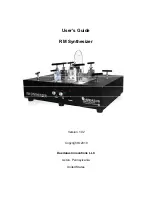
V
oice mode
Performance
mode
Multi mode
Utility mode
File mode
Master mode
Multi V
oice
mode
Sequence Play
mode
Refer
ence
Performance Edit mode
Part Edit
153
Owner’s Manual
[SF4] PORTA (Portamento)
Determines the Portamento parameters for each Part. Portamento is used to create a smooth transition in pitch
from the first note played on the keyboard to the next.
Switch
Determines whether Portamento is on or off.
Settings:
off, on
Time
Determines the pitch transition time. Higher values mean longer transition times.
Settings:
0 ~127
Mode
Determines the Portamento mode.
Settings:
fingr (fingered), full (full time)
fingr (fingered)..........Portamento is only applied when you play legato (playing the next note before releasing the previous one).
full (full time) .............Portamento is always applied.
n
The Mode setting is not available for the Plug-in Part.
n
These Portamento parameters above are not available for the Part to which the Drum Voice is assigned.
[SF5] OTHER
PB (Pitch Bend) Upper,
PB (Pitch Bend) Lower
Determines the amount and direction of Pitch Bend range. Details are same as that in the Common Edit
parameters in Normal Voice mode (page 129).
Settings:
-48 ~0 ~+24
PB (Pitch Bend) Range
This parameter is available for Plug-in Parts 1 - 3. This determines the pitch change range (in semitones) of the
Pitch Bend wheel. Unlike the Pitch Bend setting for Parts 1 - 4 to which the internal Normal Voices are assigned
described above, the Upper and Lower ranges of the Drum Voice Parts and Plug-in Parts cannot be set
independently.
Settings:
-24 ~ 0 ~ +24
VelSensDpt
(Velocity Sensitivity Depth)
Determines the degree to which the resulting volume
of the tone generator responds to your playing
strength.
The higher the value, the more the volume changes
in response to your playing strength (as shown at
right).
Settings:
0 ~ 127
VelSensOfst
(Velocity Sensitivity Offset)
Determines the amount by which played velocities are adjusted for the actual resulting velocity effect. This lets
you raise or lower all velocities by the same amount — allowing you to automatically compensate for playing
too strongly or too softly.
Settings:
0 ~ 127
[F2] OUTPUT
[SF1] VOL/PAN (Volume/Pan)
Volume
Determines the volume for each Part, giving you detailed control over the level balance among the Parts.
Settings:
0~127
Pan
Determines the stereo pan position for each Part.
Settings:
L63 (far left) ~ C (center) ~ R63 (far right)
VoiceELPan (Voice Element Pan)
Determines whether the individual pan settings for each Voice (made via [VOICE]
→
[EDIT]
→
Element
selection
→
[F4] AMP
→
[SF1] LVL/PAN
→
Pan) are applied or not. When this is set to “off,” the basic pan
position for the selected Part is set to center.
Settings:
on, off
n
This parameter is not available for the Plug-in Parts.
[SF2] EF SEND (Effect Send)
From this display you can set the Send Level and Dry Level sent to the System Effects for each Part. For details
about the Effect connection in the Performance mode, see page 122.
RevSend (Reverb Send)
Determines the send level for the Reverb effect of the selected Part, giving you detailed control over the
Reverb balance among the Parts.
Settings:
0~127
ChoSend (Chorus Send)
Determines the send level for the Chorus effect of the selected Part, giving you detailed control over the
Chorus balance among the Parts.
Settings:
0~127
127
0
127
Depth = 127
Depth = 32
Depth = 64
Depth = 0
When Offset (below) is set to 64:
Actual resulting
velocity (affecting the
tone generator)
Velocity with which you play a note
127
0
127
64
127
64
127
64
127
0
127
0
When Depth (above) = 64 and Offset = 32
When Depth (above) = 64 and Offset = 64
When Depth (above) = 64 and Offset = 96
Actual resulting
velocity (affecting
the tone generator)
Velocity with which you play a note






































